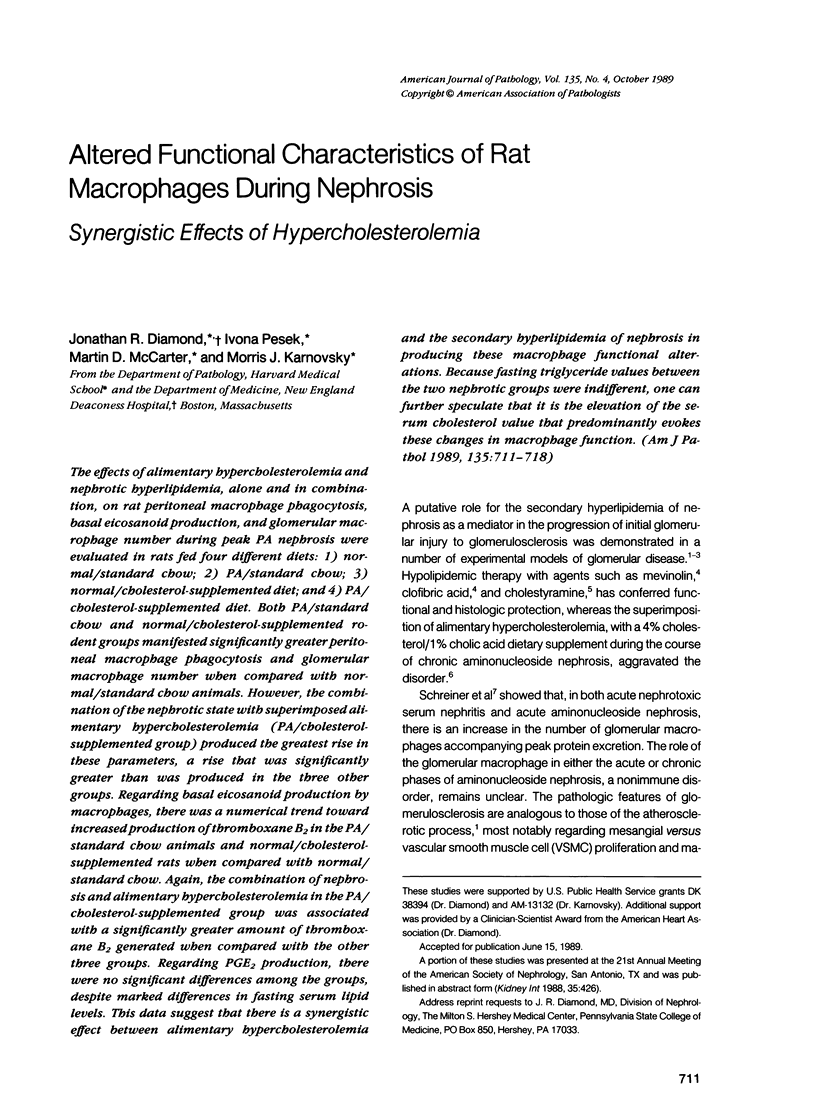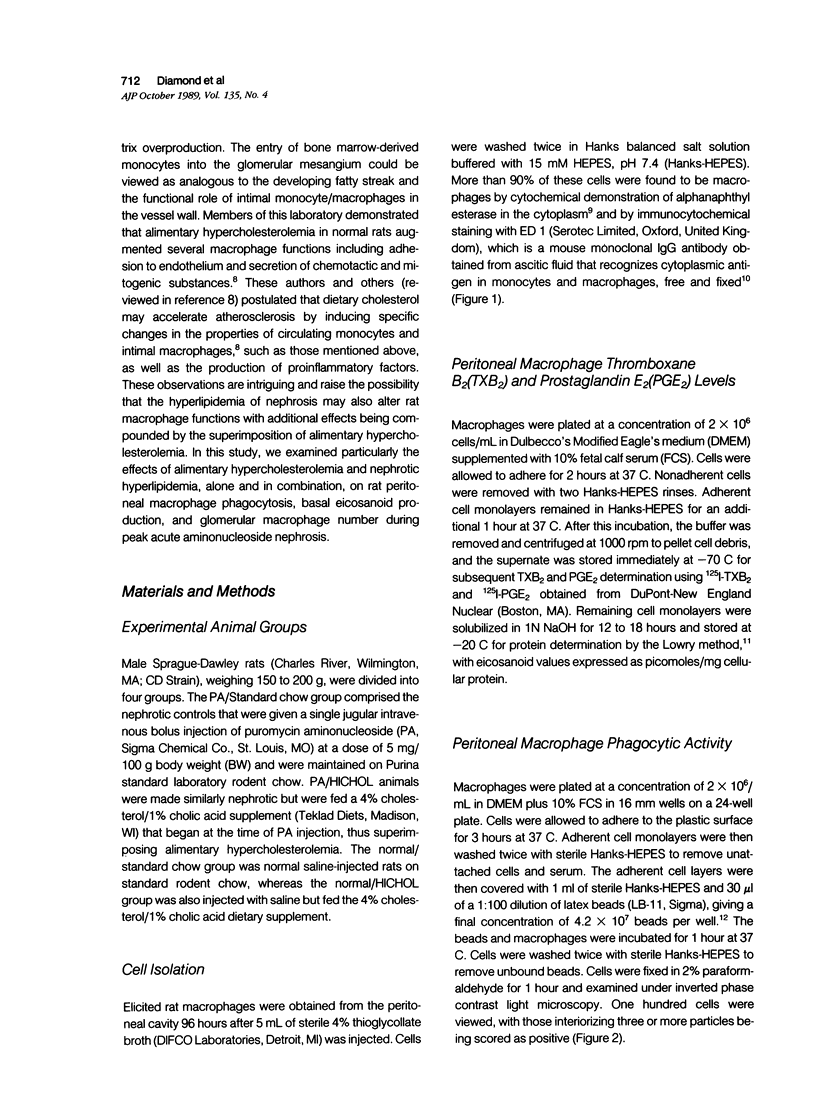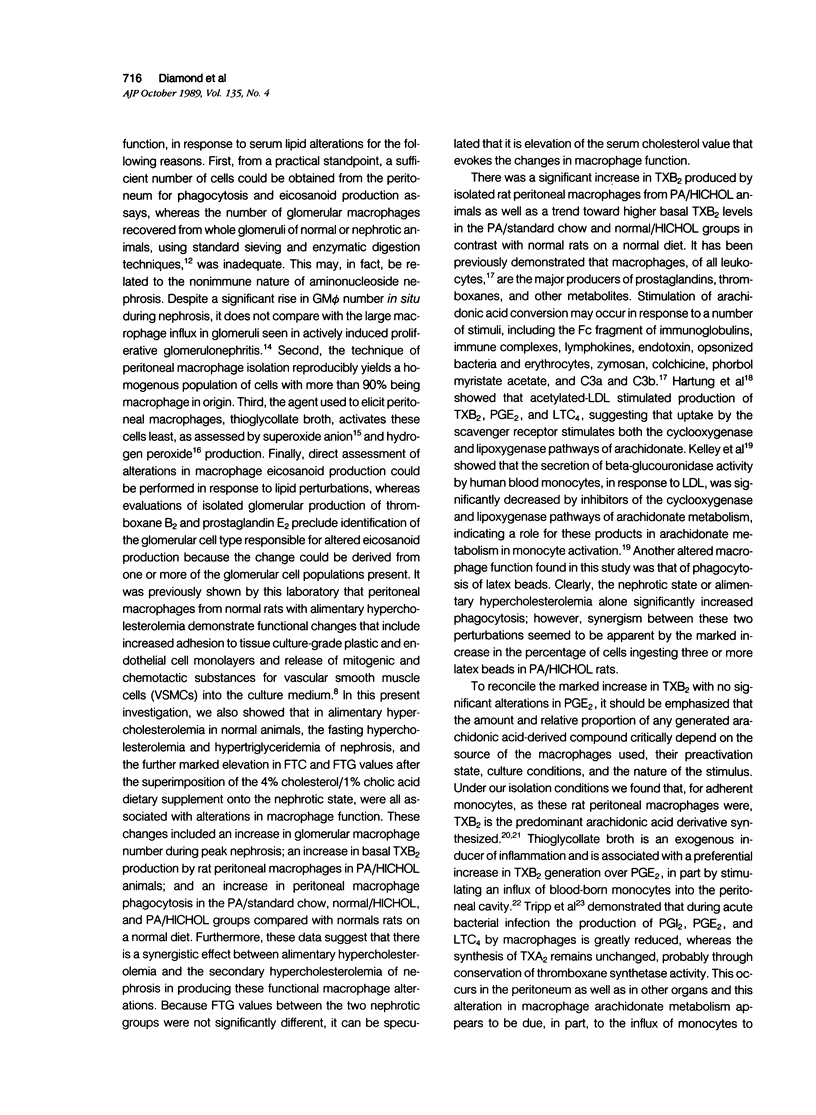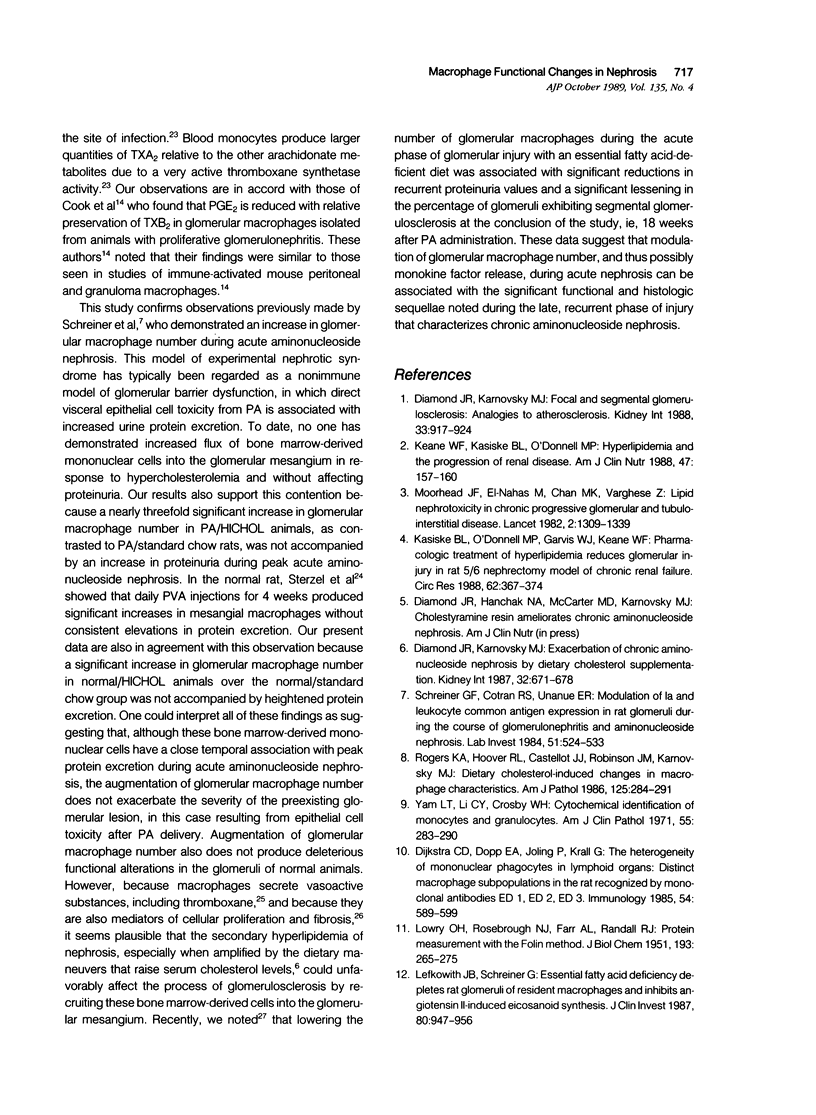Abstract
The effects of alimentary hypercholesterolemia and nephrotic hyperlipidemia, alone and in combination, on rat peritoneal macrophage phagocytosis, basal eicosanoid production, and glomerular macrophage number during peak PA nephrosis were evaluated in rats fed four different diets: 1) normal/standard chow; 2) PA/standard chow; 3) normal/cholesterol-supplemented diet; and 4) PA/cholesterol-supplemented diet. Both PA/standard chow and normal/cholesterol-supplemented rodent groups manifested significantly greater peritoneal macrophage phagocytosis and glomerular macrophage number when compared with normal/standard chow animals. However, the combination of the nephrotic state with superimposed alimentary hypercholesterolemia (PA/cholesterol-supplemented group) produced the greatest rise in these parameters, a rise that was significantly greater than was produced in the three other groups. Regarding basal eicosanoid production by macrophages, there was a numerical trend toward increased production of thromboxane B2 in the PA/standard chow animals and normal/cholesterol-supplemented rats when compared with normal/standard chow. Again, the combination of nephrosis and alimentary hypercholesterolemia in the PA/cholesterol-supplemented group was associated with a significantly greater amount of thromboxane B2 generated when compared with the other three groups. Regarding PGE2 production, there were no significant differences among the groups, despite marked differences in fasting serum lipid levels. This data suggest that there is a synergistic effect between alimentary hypercholesterolemia and the secondary hyperlipidemia of nephrosis in producing these macrophage functional alterations. Because fasting triglyceride values between the two nephrotic groups were indifferent, one can further speculate that it is the elevation of the serum cholesterol value that predominantly evokes these changes in macrophage function.
Full text
PDF







Images in this article
Selected References
These references are in PubMed. This may not be the complete list of references from this article.
- Adams D. O., Hamilton T. A. The cell biology of macrophage activation. Annu Rev Immunol. 1984;2:283–318. doi: 10.1146/annurev.iy.02.040184.001435. [DOI] [PubMed] [Google Scholar]
- Badwey J. A., Robinson J. M., Lazdins J. K., Briggs R. T., Karnovsky M. J., Karnovsky M. L. Comparative biochemical and cytochemical studies on superoxide and peroxide in mouse macrophages. J Cell Physiol. 1983 May;115(2):208–216. doi: 10.1002/jcp.1041150216. [DOI] [PubMed] [Google Scholar]
- Cook H. T., Smith J., Salmon J. A., Cattell V. Functional characteristics of macrophages in glomerulonephritis in the rat. O2- generation, MHC class II expression, and eicosanoid synthesis. Am J Pathol. 1989 Feb;134(2):431–437. [PMC free article] [PubMed] [Google Scholar]
- Diamond J. R., Karnovsky M. J. Exacerbation of chronic aminonucleoside nephrosis by dietary cholesterol supplementation. Kidney Int. 1987 Nov;32(5):671–677. doi: 10.1038/ki.1987.259. [DOI] [PubMed] [Google Scholar]
- Diamond J. R., Karnovsky M. J. Focal and segmental glomerulosclerosis: analogies to atherosclerosis. Kidney Int. 1988 May;33(5):917–924. doi: 10.1038/ki.1988.87. [DOI] [PubMed] [Google Scholar]
- Dijkstra C. D., Döpp E. A., Joling P., Kraal G. The heterogeneity of mononuclear phagocytes in lymphoid organs: distinct macrophage subpopulations in the rat recognized by monoclonal antibodies ED1, ED2 and ED3. Immunology. 1985 Mar;54(3):589–599. [PMC free article] [PubMed] [Google Scholar]
- Gown A. M., Vogel A. M. Monoclonal antibodies to human intermediate filament proteins. II. Distribution of filament proteins in normal human tissues. Am J Pathol. 1984 Feb;114(2):309–321. [PMC free article] [PubMed] [Google Scholar]
- Hartung H. P., Hadding U., Bitter-Suermann D., Gemsa D. Stimulation of prostaglandin E and thromboxane synthesis in macrophages by purified C3b. J Immunol. 1983 Jun;130(6):2861–2865. [PubMed] [Google Scholar]
- Hartung H. P., Kladetzky R. G., Melnik B., Hennerici M. Stimulation of the scavenger receptor on monocytes-macrophages evokes release of arachidonic acid metabolites and reduced oxygen species. Lab Invest. 1986 Aug;55(2):209–216. [PubMed] [Google Scholar]
- Johnston R. B., Jr Current concepts: immunology. Monocytes and macrophages. N Engl J Med. 1988 Mar 24;318(12):747–752. doi: 10.1056/NEJM198803243181205. [DOI] [PubMed] [Google Scholar]
- Kasiske B. L., O'Donnell M. P., Garvis W. J., Keane W. F. Pharmacologic treatment of hyperlipidemia reduces glomerular injury in rat 5/6 nephrectomy model of chronic renal failure. Circ Res. 1988 Feb;62(2):367–374. doi: 10.1161/01.res.62.2.367. [DOI] [PubMed] [Google Scholar]
- Keane W. F., Kasiske B. L., O'Donnell M. P. Hyperlipidemia and the progression of renal disease. Am J Clin Nutr. 1988 Jan;47(1):157–160. doi: 10.1093/ajcn/47.1.157. [DOI] [PubMed] [Google Scholar]
- Kelley J. L., Rozek M. M., Suenram C. A., Schwartz C. J. Activation of human peripheral blood monocytes by lipoproteins. Am J Pathol. 1988 Feb;130(2):223–231. [PMC free article] [PubMed] [Google Scholar]
- Kennedy M. S., Stobo J. D., Goldyne M. E. In vitro synthesis of prostaglandins and related lipids by populations of human peripheral blood mononuclear cells. Prostaglandins. 1980 Jul;20(1):135–145. doi: 10.1016/0090-6980(80)90013-1. [DOI] [PubMed] [Google Scholar]
- LOWRY O. H., ROSEBROUGH N. J., FARR A. L., RANDALL R. J. Protein measurement with the Folin phenol reagent. J Biol Chem. 1951 Nov;193(1):265–275. [PubMed] [Google Scholar]
- Lefkowith J. B., Schreiner G. Essential fatty acid deficiency depletes rat glomeruli of resident macrophages and inhibits angiotensin II-induced eicosanoid synthesis. J Clin Invest. 1987 Oct;80(4):947–956. doi: 10.1172/JCI113187. [DOI] [PMC free article] [PubMed] [Google Scholar]
- Mené P., Dunn M. J. Contractile effects of TxA2 and endoperoxide analogues on cultured rat glomerular mesangial cells. Am J Physiol. 1986 Dec;251(6 Pt 2):F1029–F1035. doi: 10.1152/ajprenal.1986.251.6.F1029. [DOI] [PubMed] [Google Scholar]
- Moorhead J. F., Chan M. K., El-Nahas M., Varghese Z. Lipid nephrotoxicity in chronic progressive glomerular and tubulo-interstitial disease. Lancet. 1982 Dec 11;2(8311):1309–1311. doi: 10.1016/s0140-6736(82)91513-6. [DOI] [PubMed] [Google Scholar]
- Morley J., Bray M. A., Jones R. W., Nugteren D. H., van Dorp D. A. Prostaglandin and thromboxane production by human and guinea-pig macrophages and leucocytes. Prostaglandins. 1979 May;17(5):729–746. doi: 10.1016/s0090-6980(79)80044-1. [DOI] [PubMed] [Google Scholar]
- Nathan C. F., Root R. K. Hydrogen peroxide release from mouse peritoneal macrophages: dependence on sequential activation and triggering. J Exp Med. 1977 Dec 1;146(6):1648–1662. doi: 10.1084/jem.146.6.1648. [DOI] [PMC free article] [PubMed] [Google Scholar]
- Rogers K. A., Hoover R. L., Castellot J. J., Jr, Robinson J. M., Karnovsky M. J. Dietary cholesterol-induced changes in macrophage characteristics. Relationship to atherosclerosis. Am J Pathol. 1986 Nov;125(2):284–291. [PMC free article] [PubMed] [Google Scholar]
- Schreiner G. F., Cotran R. S., Unanue E. R. Modulation of Ia and leukocyte common antigen expression in rat glomeruli during the course of glomerulonephritis and aminonucleoside nephrosis. Lab Invest. 1984 Nov;51(5):524–533. [PubMed] [Google Scholar]
- Sterzel R. B., Eisenbach G. M., Seiler M. W., Hoyer J. R. Uptake of polyvinyl alcohol by macrophages in the glomerular mesangium of rats. Histologic and functional studies. Am J Pathol. 1983 May;111(2):247–257. [PMC free article] [PubMed] [Google Scholar]
- Tripp C. S., Needleman P., Kassab J. T., Weinstock J. V. Macrophages isolated from liver granulomas of murine Schistosoma mansoni synthesize predominantly TxA2 during the acute and chronic phases of infection. J Immunol. 1988 May 1;140(9):3140–3143. [PubMed] [Google Scholar]
- Yam L. T., Li C. Y., Crosby W. H. Cytochemical identification of monocytes and granulocytes. Am J Clin Pathol. 1971 Mar;55(3):283–290. doi: 10.1093/ajcp/55.3.283. [DOI] [PubMed] [Google Scholar]





